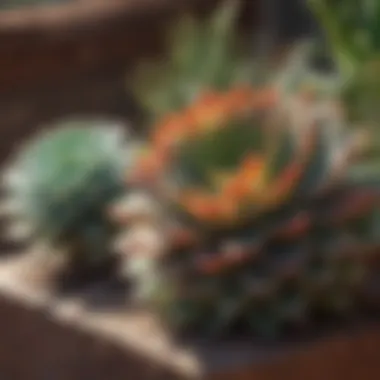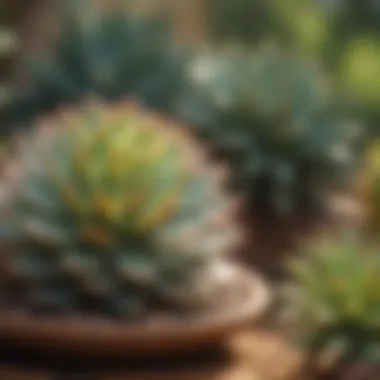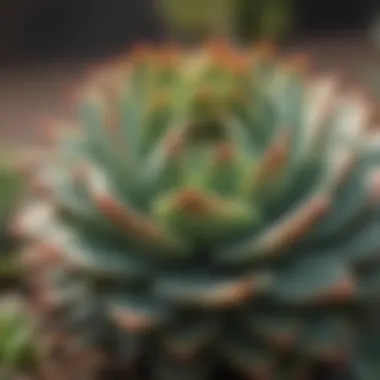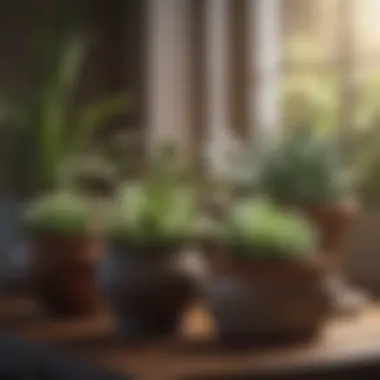Optimal Sun Exposure for Thriving Succulents


Intro
Succulents have gained immense popularity in recent years due to their unique appearance and low maintenance needs. Understanding their optimal sun exposure is crucial for their health and vitality. Improper sunlight can lead to a myriad of issues, including stunted growth or, worse, plant death. This guide delves into the specifics of sunlight requirements for succulents, providing insights tailored for both novice and experienced gardeners.
Fascinating Facts About Succulents
Unique Characteristics
Succulents are not just visually appealing; they possess remarkable adaptations that allow them to thrive in arid conditions. These plants store water in their leaves, stems, or roots, which grants them the ability to survive long periods without direct access to water. Most succulents have thick, fleshy leaves that serve as reservoirs. Some species, like the Aloe Vera, also have additional medicinal properties, adding to their desirability in both gardening and health remedies.
Extraordinary Abilities
One of the most notable aspects of succulents is their capacity to photosynthesize efficiently, even under conditions of limited sunlight. Cacti and other succulents utilize a specialized form of photosynthesis called CAM (Crassulacean Acid Metabolism). This allows them to open their stomata at night to absorb carbon dioxide, reducing water loss typically associated with daytime photosynthesis. Such adaptations make them ideal for environments where sunlight exposure varies significantly throughout the day.
Understanding Sunlight Needs
Succulents require varying amounts of light depending on the species. Here are some key points:
- Full sun: Some succulents, like Echeveria and Sedum, thrive in full sun with at least six hours of direct sunlight daily.
- Partial shade: Others, such as the Haworthia, prefer bright, indirect light and may suffer in harsh direct sun.
- Low light: Certain varieties can survive in minimal light conditions, but their growth may slow significantly.
It's important to research specific species to ensure optimal growth conditions.
Factors Influencing Sun Exposure
Several factors can impact how much sunlight a succulent should receive:
- Species Type: Knowing whether a succulent is a shaded or sun-loving variety will dictate its sun exposure needs.
- Location: Indoor succulents may need supplemental light sources, like grow lights, to mimic natural daylight.
- Season: Outdoor succulents may need protection during the most intense summer months to prevent sunburn.
Risks of Inadequate or Excessive Sunlight
Understanding the balance of sunlight is crucial. Too much sun can lead to:
- Sunburnt leaves that turn brown and crispy.
- Stunted growth due to stress.
Conversely, too little sun can result in:
- Leggy growth as the plant stretches towards the light.
- Fungal infections or rot in overly shaded or damp conditions.
The End
Proper sun exposure is a fundamental part of nurturing succulents. By educating oneself on specific species and their light requirements, you can ensure the long-term health and beauty of these resilient plants. Through careful observation and adjustments based on seasonal changes, even novice gardeners can achieve thriving succulent arrangements.
Preface to Succulent Plants
Succulents are more than just attractive foliage; they represent a sustainable and adaptable choice for gardeners. Understanding them is vital for ensuring their optimal growth. This section delves into the basic definitions and characteristics that make succulents unique, as well as introduces some common varieties that enthusiasts might encounter.
Definition and Characteristics
Succulents are plants that have adapted to arid climates by storing water in their leaves, stems, or roots. This ability allows them to thrive in environments where many other plants would struggle. Their fleshy parts come in a variety of shapes, sizes, and colors, which make them appealing not just for their hardiness but also for their aesthetic qualities.
The key characteristics of succulents include:


- Water Storage: The hallmark of succulents is their ability to retain water. This adaptation provides the necessary resources during drought.
- Types of Leaves: Leaves can be thick and fleshy or modified into spines, minimizing water loss. The variation provides a rich palette for gardeners.
- Growth Habit: Many succulents exhibit a rosette form, while others may spread out or grow upright. This diversity can cater to varied garden designs.
- Photosynthesis Type: Succulents primarily employ CAM (Crassulacean Acid Metabolism) photosynthesis, which allows them to use sunlight more efficiently.
Common Varieties of Succulents
The world of succulents includes a diverse array of species, each with its distinct characteristics and care requirements. Some prevalent varieties include:
- Aloe Vera: Well-known for its medicinal properties, Aloe Vera needs bright, indirect sunlight.
- Echeveria: Popular due to its rosette shape and variety of colors, Echeveria thrives in full sun.
- Jade Plant (Crassula ovata): Symbolic of good luck, this plant prefers bright light but can tolerate some shade.
- Hens and Chicks (Sempervivum): A resilient choice, they adapt well to various growing conditions.
- Sedum: There are many types, with some offering ground cover and others presenting beautiful flowers.
Sunlight Requirements for Succulents
Understanding the sunlight requirements for succulents is fundamental to their health and longevity. Sunlight is a crucial element that influences the overall well-being of these plants. Many factors come into play when considering how much sun a succulent needs, including its species and the environment in which it grows. Proper sun exposure leads to robust growth, vibrant colors, and enhanced resilience against pests and diseases. Understanding these requirements can help you create an optimal growing condition that benefits your plants.
Understanding Light Needs
Succulents have evolved to thrive in bright, sunny environments. The majority of these plants originate from arid regions where sunlight is abundant. As such, they have developed certain adaptations to optimize their light intake. For instance, succulents possess thick, fleshy leaves and stems, which enable them to store water and efficiently absorb sunlight. This unique structure is vital for their survival and growth. Additionally, the angle and intensity of sunlight can affect how a succulent grows.
Key Absorption Factors
- Light Intensity: High light levels are preferable. Most succulents need at least 6 hours of direct sunlight daily.
- Duration of Exposure: Gradually introducing your succulents to intense lighting is essential. Sudden changes can shock them.
- Light Quality: Natural sunlight is best, as grow lights may not fully replicate the spectrum that succulents require.
Understanding these light needs can aid in selecting the right location for your succulents, making it essential for any gardener.
General Guidelines for Sun Exposure
General guidelines for sun exposure can significantly assist in sustaining healthy succulents. Each succulent species has distinct sunlight needs. Some thrive in direct sunlight, while others prefer filtered light. It is essential to note the differences and provide suitable environments accordingly.
Recommendations
- Direct Sunlight: Most succulents enjoy direct sun for several hours each day. This category includes popular types like the Echeveria and Sedum.
- Partial Shade: Succulents like Haworthia do better in partial shade, especially during extreme heat conditions.
- Rotation: Regularly rotate your succulents to maintain balanced growth. Uneven exposure may lead to leaning or stretching.
Proper sunlight ensures that succulents develop their characteristic forms and colors, reinforcing their beauty and health.
Following these general guidelines will enhance your ability to care for these plants effectively. With the right sun exposure, succulents can thrive, becoming a joyful part of your garden or home.
Factors Influencing Sunlight Needs
Understanding the factors that influence sunlight needs in succulents is essential for their proper care. Not all succulents behave the same way under the sun. Different species have unique adaptations and preferences when it comes to light exposure. This section will examine critical elements such as species-specific requirements, climate and geographical considerations, and the differences between indoor and outdoor growth conditions.
Species-Specific Requirements
Succulents come in various species and, therefore, exhibit a range of light preferences. Some may thrive under full sun conditions, while others prefer partial shade. For example, Aloe vera generally enjoys direct sunlight but can adapt to indirect light. In contrast, Echeveria species typically benefit from bright but filtered light to avoid stress that can be caused by too much sun.
It's also vital to consider the lifecycle stages of the plants. Young succulents may be more sensitive and require more protection from harsh sun rays. Understanding the specific needs of your succulent can prevent issues associated with light exposure, like etiolation or stunted growth. Generally, achieving the right light balance plays a crucial role in ensuring the long-term health of succulents.
Climate and Geographic Considerations
Climate affects sunlight availability and quality. In regions with high temperatures and lots of sunlight, succulents may require some shade during the hottest parts of the day. On the other hand, in cooler areas, they may thrive with more direct light exposure. Humidity can also influence how succulents react to light; too much humidity and direct sunlight can lead to fungal problems.
Geographical location also matters. For instance, succulents growing at higher altitudes, where UV radiation is stronger, will tolerate more direct sunlight compared to those at lower, more humid altitudes. When cultivating succulents, it's important to understand these environmental factors. They shape the care routines and growing conditions for optimal plant health.
Indoor vs.
Outdoor Growth Conditions


When growing succulents indoors, light exposure can be significantly different from outdoor conditions. Indoor light is often filtered and may not provide the same intensity as outdoor sunlight. Therefore, it's essential to place succulents near bright windows, preferably south-facing ones, where they can get adequate light.
However, overexposure to afternoon sun can burn indoor succulents, especially if they are not acclimated to such conditions. Conversely, succulents outdoors may face different challenges, such as fluctuating temperatures and wind. While they may receive bright light, outdoor plants must also endure sudden changes in weather. Understanding these differences helps in managing sunlight exposure effectively and promoting healthy growth for both indoor and outdoor succulents.
Knowledge of factors that influence sunlight needs is crucial in succulent care. This awareness provides a foundation for creating optimal growing conditions.
Signs of Optimal Light Exposure
Understanding the signs of optimal light exposure for succulents is crucial for their thriving. This section aims to help you identify indicators that suggest your plants are receiving just the right amount of sunlight. When succulents get adequate light, they display healthy growth and vibrant colors. Recognizing these signs allows for better adjustments in their care, ensuring they remain healthy and decorative additions to your space.
Healthy Growth Indicators
Healthy growth indicators are perhaps the most telling signs of adequate sunlight. When succulents receive enough light, their growth rate typically increases. Here are key indicators to watch for:
- Robust foliage: Leaves should appear plump and firm, which reflects proper hydration and nutrition.
- New growth: Look for new leaves developing at the top or sides of the plant. This cell division indicates the plant is thriving.
- Stable posture: Succulents should stand firm and upright; drooping can indicate a problem with light exposure or moisture levels.
In addition to these signs, observe the plant's overall vitality. A succulent that displays vibrant greens or rich colors usually signals adequate sun exposure. While some variations exist among species, the overall trend remains consistent across many succulent varieties.
Color and Textural Changes
Color and textural changes serve as significant visual cues regarding the health of succulents in relation to sunlight. Specifically, when succulents are correctly exposed to light, they often exhibit:
- Vivid colors: Many succulents develop deeper shades under optimal sunlight; hues may range from lush greens to vibrant reds and purples.
- Firmer textures: Proper sun exposure typically leads to firmer leaves, preventing them from becoming spongy or mushy.
However, watch out for the opposite signs as well. If a succulent appears washed out or excessively pale, it may be receiving too much sunlight or not enough nutrients. Conversely, if the plant becomes elongated and leggy, it often seeks sunlight, a sign that it is not getting enough.
Proper light conditions can enhance the beauty and vitality of your succulents, making them not only resilient but also visually appealing.
Consequences of Insufficient Sunlight
Insufficient sunlight can pose a significant threat to the health and vitality of succulent plants. These hardy plants, which have adapted to thrive in arid environments, require a certain amount of sunlight to maintain their strength and beauty. Lack of adequate light can lead to a series of adverse effects that can compromise their overall well-being.
Common Symptoms of Weakness
When succulents receive insufficient sunlight, they often exhibit several symptoms indicating distress. These signs include:
- Stretching: Succulents tend to elongate in search of light. This can result in a weak, spindly appearance that makes them more prone to breakage.
- Discoloration: Leaves may lose their vibrant hues, turning pale or yellowish. This lack of pigmentation can be due to the plant's inability to photosynthesize effectively without enough light.
- Leaf Drop: In a desperate attempt to conserve energy, succulents may start shedding leaves. This is especially common in species like jade plants and Echeveria.
- Slowed Growth: Limited sunlight can lead to a significant slowdown in growth rates. The plant may become dormant instead of thriving.
These symptoms serve as crucial warning signs. It is important to identify them early to avoid prolonging the plants’ struggle.
Long-Term Health Impacts
The long-term health impacts of insufficient sunlight can be severe, even leading to death if not addressed promptly. The consequences include:
- Compromised Root Systems: Lack of light can weaken root development, making the plant dependent on the surrounding soil for hydration. This may lead to root rot, a more serious problem that can kill the plant.
- Increased Susceptibility to Pests: Stressed succulents are more vulnerable to pest infestations. They may struggle to defend themselves against common nuisances like mealybugs or aphids, which can further exacerbate their decline.
- Reduced Lifespan: Continuous exposure to low light can shorten the overall lifespan of succulents. The ongoing stress diminishes their vitality, making them less resilient over time.
- Permanent Damage: Some species may incur permanent structural damage from prolonged weak states. This can alter their natural growth patterns and overall appearance for the rest of their lives.
Given these considerations, it becomes clear that ensuring sufficient sunlight is critical. Addressing light needs is one of the essential aspects of proper succulent care.
Succulents are resilient, but their health hinges on adequate sunlight exposure.
Dangers of Excessive Sunlight


Excessive sunlight can be just as detrimental to succulents as insufficient light. Understanding the potential risks of too much sun exposure is essential for maintaining the health of these resilient plants. When succulents receive too much direct sunlight, they may exhibit signs of stress that can compromise their growth and vitality. This section covers the consequences of overexposure, providing insights into recognizing issues early and making appropriate adjustments.
Signs of Sunburn in Succulents
Succulents are often believed to be sun-loving plants, but this does not mean they are immune to sunburn. When a succulent experiences too much sunlight, you might notice a variety of symptoms. Some common indicators include:
- Browning or blackened patches: These areas often appear on the leaves that are exposed to the most direct sunlight. This discoloration is a clear sign of sunburn.
- Wilting or softening of leaves: Overexposure can lead to dehydration, causing leaves to become limp or mushy.
- Leaf drop: If a succulent is under stress due to excessive sun, it may shed leaves to conserve moisture.
If you observe any signs of sunburn, it is crucial to act quickly. Prolonged exposure to harsh sunlight can lead to severe damage and ultimately harm the plant's health.
Adjusting for Overexposure
To mitigate the effects of excessive sunlight, it is important to make adjustments in the succulent's environment. Here are several strategies:
- Change Placement: Move your succulents to a location where they can receive indirect sunlight, particularly during peak hours of the day. A shaded area can provide relief and prevent further damage.
- Use Shade Cloths: Installing shade cloths can help filter sunlight, protecting your succulents from the full intensity of the sun. This is particularly helpful during the summer months when sunlight is strongest.
- Acclimate Slowly: If a succulent has been in a low-light environment and is suddenly exposed to intense sunlight, allow for a gradual increase in light exposure. This helps the plant adapt without incurring damage.
Tips for Managing Sunlight Exposure
Managing sunlight exposure for succulents is crucial for their growth and vitality. Each succulent species has its own specific light requirements, which can greatly influence their overall health. Understanding these needs allows gardeners to create the optimal environment for their plants. Proper management of sunlight can lead to a more vibrant and thriving collection of these unique plants. Careful planning of light exposure can help avoid common issues like sunburn or insufficient light, thus ensuring longevity and health.
Optimal Placement for Sunlight
Placement is key in providing the right sun exposure for succulents. Ideally, succulents thrive in bright, indirect sunlight, especially in indoor settings. A south-facing window is often recommended, as it typically receives the most consistent light throughout the day.
Here are several considerations when placing succulents:
- Windowsill Position: A south-facing windowsill is often ideal. However, ensure that the light is not too harsh if the sunlight is direct for prolonged periods.
- Outdoor Conditions: If growing outside, place succulents where they receive morning sun and afternoon shade. This balance helps prevent sunburn while still allowing for adequate light.
- Rotate Plants: Regularly rotate pots to ensure all sides of the plant receive equal sunlight, promoting even growth.
By properly evaluating the location and light dynamics within your space, you can maximize the health of your succulents.
Use of Shade Cloths and Filters
Shade cloths and filters can be effective tools for managing sunlight exposure, especially in extreme climates. These materials can diffuse harsh sunlight or protect plants from the intensity of midday rays. Here’s how to effectively use them:
- Material Choices: Shade cloths come in various densities. A 30-50% shade cloth is commonly used for succulents. It allows enough light for photosynthesis while protecting from sun damage.
- Installation: Place shade cloth horizontally over plants or utilize a frame to create a more permanent solution in outdoor settings. Adjust the height based on the sun's angle.
- Temporary Filters: For short periods of intense sunlight, consider using sheer curtains or lightweight fabrics indoors to provide a gentle filter.
Using shade cloths can help maintain ideal growing conditions, especially during hot summer months.
Seasonal Adjustments
Sunlight requirements may change with the seasons. Succulents might need different care during warmer months compared to the colder ones. Here are some tips for making seasonal adjustments:
- Spring and Summer: Increase exposure gradually as the weather warms. Monitor for signs of stress, such as fading colors or drooping leaves.
- Fall and Winter: As light levels decrease, consider moving your succulents closer to windows or using grow lights to provide the necessary amount of light.
- Regular Monitoring: Be vigilant and adjust placements accordingly, as factors like cloud cover or seasonal changes can affect light availability.
It is essential to adapt your succulent care to seasonal variations to promote continuous growth and health.
By paying attention to these adjustments, gardeners can ensure their succulents receive the right amount of sunlight throughout the year.
Epilogue
Understanding the sunlight needs of succulents is essential for their well-being and growth. This article sheds light on how different species respond to varying degrees of sun exposure, emphasizing the importance of tailored care. We have explored the consequences of insufficient sunlight and the dangers of excess exposure, providing a balanced view of what succulents typically require.
Summary of Key Points
In summary, the following points are crucial for caring for succulents effectively:
- Different succulent species have unique sunlight requirements.
- Monitoring signs of healthy growth can indicate if succulents are getting the right amount of light.
- Insufficient sunlight can lead to various health issues in plants.
- Overexposure to sunlight results in sunburn and other detrimental effects.
- Using strategic placement and implements like shade cloths can help manage exposure.
Overall, understanding these elements allows for better management of succulent health and growth.
Final Thoughts on Succulent Care







